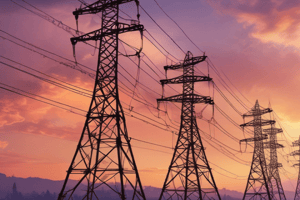Podcast
Questions and Answers
What voltage range is typically associated with primary distribution lines?
What voltage range is typically associated with primary distribution lines?
- 240V
- 120V
- 500kV
- 4kV - 35kV (correct)
Which of the following pairs represents the two main types of distribution lines used in electrical power systems?
Which of the following pairs represents the two main types of distribution lines used in electrical power systems?
- High-voltage and Low-voltage
- AC and DC
- Single-phase and Three-phase
- Overhead and Underground (correct)
Which device is specifically designed to reduce voltage levels in a distribution system?
Which device is specifically designed to reduce voltage levels in a distribution system?
- Generator
- Circuit breaker
- Transformer (correct)
- Capacitor
Which type of lines directly supply power from substations to end consumers?
Which type of lines directly supply power from substations to end consumers?
What is the primary drawback associated with using underground distribution lines compared to overhead lines?
What is the primary drawback associated with using underground distribution lines compared to overhead lines?
Which type of distribution line is most often utilized in rural environments?
Which type of distribution line is most often utilized in rural environments?
What is the primary function of insulators used on overhead distribution lines?
What is the primary function of insulators used on overhead distribution lines?
What is the primary purpose of distribution lines in an electrical power system?
What is the primary purpose of distribution lines in an electrical power system?
What is a significant advantage of using underground distribution lines compared to overhead lines?
What is a significant advantage of using underground distribution lines compared to overhead lines?
Which material is most commonly used as a conductor in distribution lines due to its conductivity and cost-effectiveness?
Which material is most commonly used as a conductor in distribution lines due to its conductivity and cost-effectiveness?
Flashcards
Primary distribution voltage
Primary distribution voltage
4kV-35kV is a common voltage range used in primary distribution lines to efficiently transmit electricity over shorter distances.
Types of distribution lines
Types of distribution lines
Overhead lines are suspended in the air and are cheaper, while underground lines are buried and are more expensive but less visible.
Voltage step-down device
Voltage step-down device
A transformer steps down high-voltage electricity to lower voltages suitable for distribution to homes and businesses.
Power Delivery Lines
Power Delivery Lines
Signup and view all the flashcards
Disadvantage of underground lines
Disadvantage of underground lines
Signup and view all the flashcards
Common rural distribution lines
Common rural distribution lines
Signup and view all the flashcards
Purpose of insulators
Purpose of insulators
Signup and view all the flashcards
Main purpose of distribution lines
Main purpose of distribution lines
Signup and view all the flashcards
Advantage of underground lines
Advantage of underground lines
Signup and view all the flashcards
Distribution line conductor material
Distribution line conductor material
Signup and view all the flashcards
Study Notes
- Common voltage level for primary distribution lines is 4kV - 35kV.
- The two main types of distribution lines are overhead and underground.
- A transformer is used to step down voltage in a distribution system.
- Distribution lines deliver power from substations to consumers.
- A main disadvantage of underground distribution lines is that they are more expensive to install and repair.
- Overhead lines are commonly used in rural areas.
- Insulators on overhead distribution lines prevent electrical leakage and support conductors.
- The main purpose of distribution lines is to deliver electricity from substations to consumers.
- A main advantage of underground distribution lines over overhead lines is more resistance to weather-related damage.
- Aluminum or copper is commonly used for distribution line conductors.
- Underground distribution lines are preferred in urban areas because they improve safety and aesthetics.
- Secondary distribution lines operate at lower voltages and deliver electricity directly to consumers.
- Underground distribution lines are more expensive than overhead lines because the installation process is more complex.
- Common reasons for power outages in distribution lines include tree branches touching power lines, equipment failure and weather conditions.
- A major factor that affects the choice between overhead and underground distribution lines is cost, safety, and environmental factors.
Studying That Suits You
Use AI to generate personalized quizzes and flashcards to suit your learning preferences.




